I don’t’ know her real name so I’ll just call her Rachel.
But first a little (a lot of?) background about why this seemingly small gesture meant so much to me.
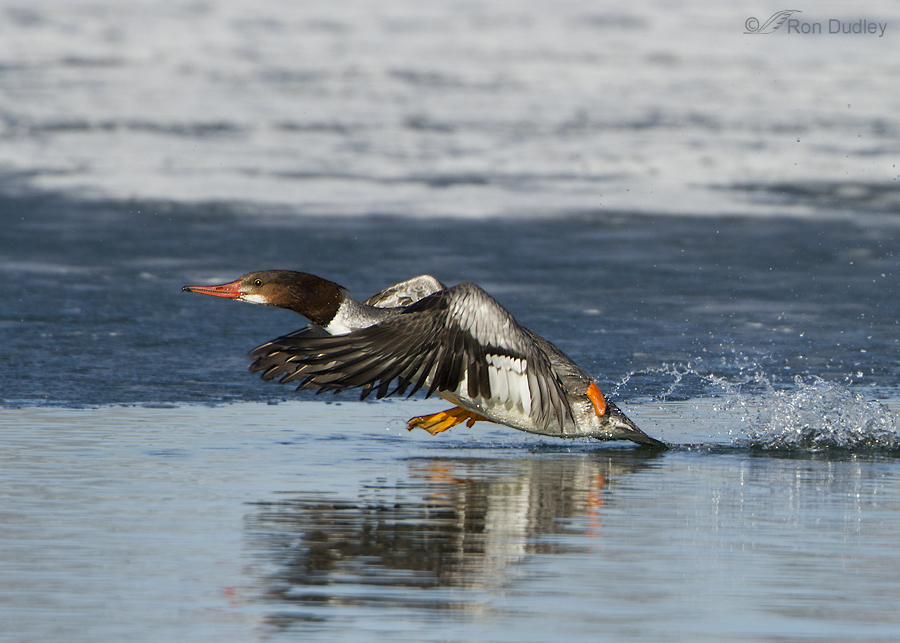
I regularly haunt several local ponds for birds and one of them has had a huge problem with discarded fishing line for years. I often see discarded monofilament line on the pond edges, birds with line trailing from their extremities and occasionally birds with missing legs almost certainly caused by fishing line cutting off circulation. Once at this pond I even photographed a merganser with a fish hook stuck in its bill and on another occasion in my very early blogging days I photographed the same thing with an adult Bald Eagle in northern Utah.
For me one of the most memorable victims at the pond was this Common Merganser missing its left foot. But this bird was a true survivor. Can you imagine trying to catch fish underwater with one webbed foot missing? And notice how fast it’s running on top of the water with that handicap. This bird wasn’t taking off, instead it was chasing after another merganser with a fish.
The stump churning uselessly in midair almost broke my heart.
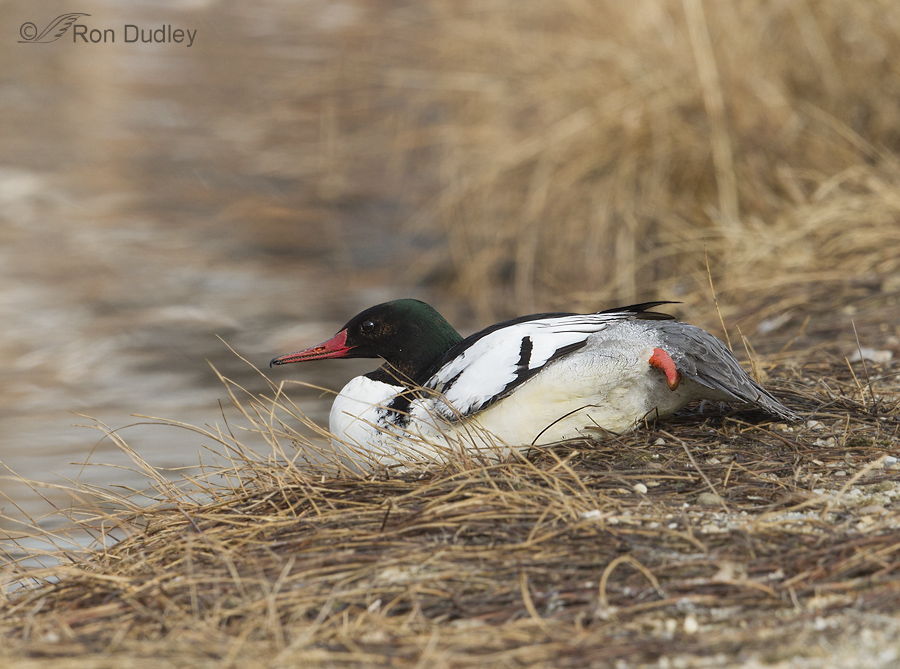
The following winter I found what was apparently the same bird, now an adult in breeding plumage, resting on the shore of the same pond. This bird was obviously thriving even with the missing foot. I saw him multiple times that winter and became quite attached to him.
And speaking of attached…
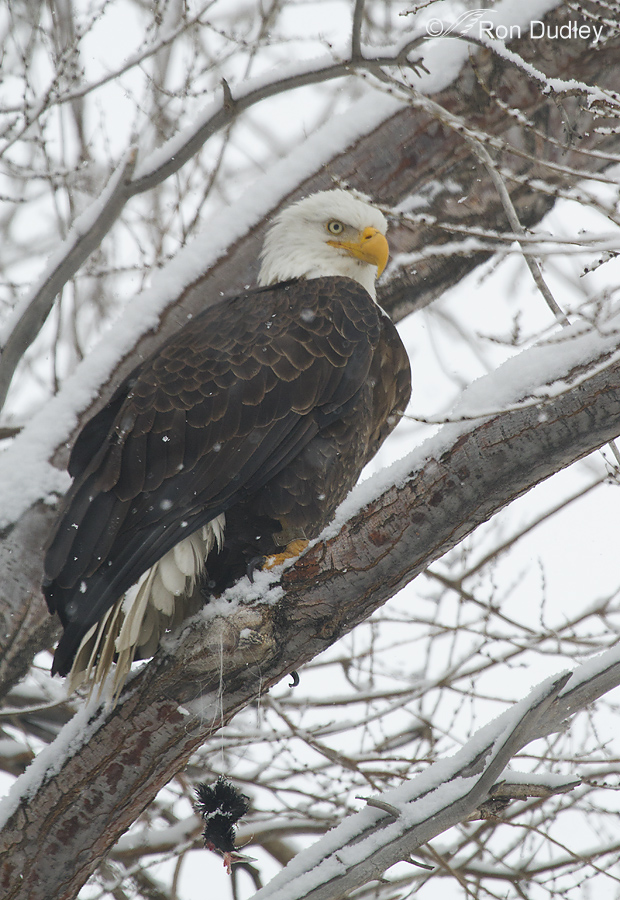
This is the adult Bald Eagle that used the huge elm tree in my yard as a roost for much of December and part of January for multiple years almost like clockwork. The eagle was attracted to my tree because it’s near the pond where it hunted for waterfowl and presumably fish, my home is on a hill and that tree was the tallest tree in the entire area. The eagle felt safe and secure so close to its food source.
But on the afternoon I took this photo I saw something highly disturbing. Look carefully and you’ll see fishing line hanging down from the eagle with the apparent remains of a coot attached to one end. I can only surmise that the coot became entangled in the line at the pond which made it easy prey for the eagle who then became a second victim of the line. When the eagle took off from this perch it somehow left the fishing line and coot remains behind. You can imagine my relief!
Some years ago I contacted Tom Wharton, a long-time and highly respected outdoor columnist for the Salt Lake Tribune (and the father of one of my ex-students) about the problem with discarded fishing line at this pond. Tom met us down at the pond to see the problem for himself and became incensed enough by what he saw to feature an article about it in the Trib. City parks then installed fishing line disposal stations on the perimeter of the pond (I don’t think the Parks Department is particularly fond of bad publicity but I still give them credit for eventually doing the right thing.) Those disposal stations have helped but too many anglers are what I call “slob fishermen” so the problem persists.
Ok, now to my point. Finally.
Meet “Rachel” and her dog.
Yesterday while I was looking in vain for interesting birds to photograph at the pond I spotted Rachel walking her dog on the far side of the pond and about 150 yards away. She first caught my attention when I saw her properly dispose of a dog poop bag. That always gets my attention because there seems to be as many “slob dog owners” as there are slob fishermen so I thought “good for her”.
A few minutes later I was surprised when I saw her pick up something else near the pond because I thought her dog probably hadn’t pooped a second time already so out of curiosity I aimed my lens her way once again. But this time she had picked up a long piece of discarded monofilament fishing line with leaf and twig debris attached. I’m not sure why but in this shot she appears to be taking a photo of the fishing line with her phone. I didn’t notice that until I looked at the photo on my computer.
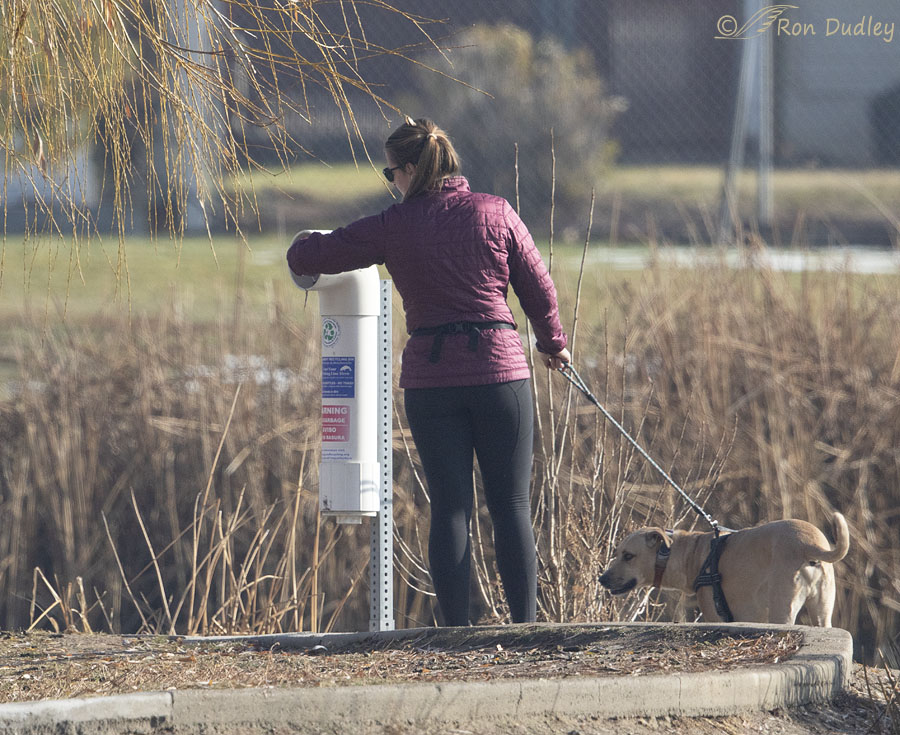
And then she and her dog walked some distance out of her way to properly dispose of the line at one of the disposal stations. Once again the phrase “good for her” came to mind. And she’s not even a fisherman.
So when she eventually made her way all the way around the pond I made it a point to thank Rachel for her good deed. She’s a very pleasant young woman. She said that she visits the pond regularly and has noticed multiple birds entangled in line, the implication being that it was her way of preventing further avian mayhem.
Her good deed may seem like a little thing but to me it’s a big deal.
And to birds it’s huge.
Ron
Notes:
- I called her “Rachel” because I admire Rachel Carson so much and I felt I should call her something. I also give her credit for having her dog leashed. Too many dog owners at this pond simply ignore that well-posted park rule.
- Some convoluted irony: After properly disposing of her own dog’s poop I saw her scraping poop off of one of her shoes when she completed her trip around the pond. It could have been goose or duck poop or poop from someone else’s dog.
- I attempted to provide a link to Tom Wharton’s article in the Tribune but it’s no longer available.
- I had to take out my huge elm tree early this past spring. It was a danger to my house and they’re “trash trees” that create a huge mess. But especially this time of year I’m wondering how “my” eagle is faring without the tree. Yesterday we spotted what was most likely a Bald Eagle in a clump of trees perhaps a half-mile southwest of the pond and wondered if it could be the same bird.


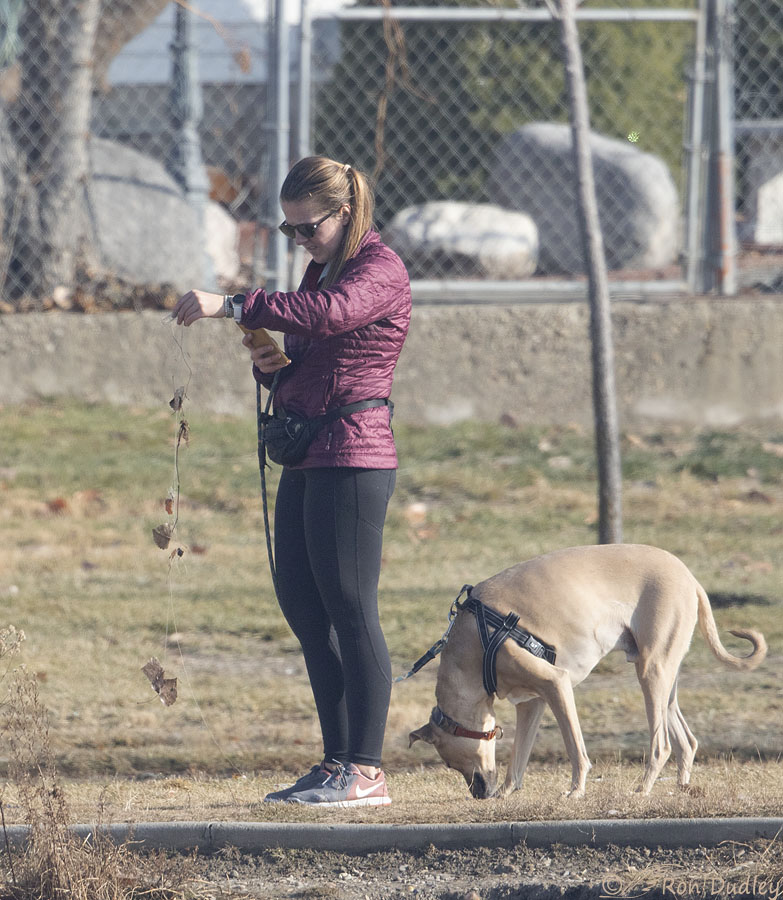
I work with a raptor rehabilitation organization in Maryland and we see far too many ospreys – adults, nestlings and fledglings – entangled in fishing line or pierced by fish hooks. During a banding trip last summer on the Chesapeake Bay, it wasn’t unusual to find fishing line in osprey nests. Lead fishing tackle is problem too. I don’t understand how people who consider themselves to be sportsman can behave so carelessly. But it’s wonderful to know that there are people making the effort to clean up their mess. It’s also wonderful to see the merganser doing so well in spite of his handicap.
I wholeheartedly agree with your opinions regarding fishing line, not only for the sake of birds and wildlife, but for people as well. We should all do as Rachel did, and all fishermen should take responsibility for tangled or broken line.
One other comment is that I believe the mergansers in your beautiful photos are not the same bird. If I’m not mistaken, the first has plumage of a female, and the second seems to be a male. What is incredible is that the two seem to have identical amputations of the foot. They truly are survivors!
I so appreciate the clarity of your photos and the fact that you seem able to capture decisive moments in the life of birds.
Thanks, Phoebe.
Here’s what Dick Harlow said about them being the same bird or not when I posted those two photos the first time:
“I believe you are correct, but not just because of the missing foot. Although I took a double take when you mentioned the two pictures being the same bird, I noticed one major field characteristic that proves you right!
Field Guides show the first spring male looking like a female, but having a black collar at the base of the rufous head and throat that shows up as this bird is flying.
Great shots Ron, and a wonderful example of why field marks matter!!”
https://www.featheredphotography.com/blog/2015/03/03/one-footed-merganser-giving-up-on-an-old-friend/
Thanks for the feedback. I’m so glad to learn this. None of my books mention it.
I enjoy watching flocks of common mergansers every year as they herd fish down our lake to feed, but they are only here during winter migration. I don’t get to see them in the spring.
Very encouraging story, Ron. We have regular beach cleanups here. It’s maddening to see the stuff people leave and what washes up on shore, but good to be with people (especially young ones like Rachel) who turn out to help clean it up.
Lyle, there’s all kinds of people. I just have to remind myself sometimes that there really are some good ones out there.
“Rachel” is a good soul.
She surely is.
Ron, this is both a heartwarming and disturbing post. Thank goodness for people like Rachel and you. It is appalling to hear the stories about ‘morons’ who don’t clean up after themselves. You are right – they just don’t care. I think that birds have a hard life to start with and then having to deal with this makes it even harder. It makes me sad. Thank you for this post, Ron
Thanks very much, Alice.
It is a huge deal.
Many thanks to Rachel and all her clan. You included.
Thank you, EC.
You’re a biologist.could we please clone “RACHEL”???
Wish I could, Patty. Not in my job description though…
Ron, thank you for this post.
You’re very welcome, Nancy.
Good for her! Seems when I leave ponds, lake, rivers, ect. I leave with a pocket full of line, hooks and beer cans. I have started stuffing a garbage bag into my camera gear to take for the hikes.
April, I used to carry a garbage bag in the back of my pickup but when my back issues became bad enough it just became too uncomfortable to be getting into and out of my pickup all the time.
Not a “ little” thing at all, picking up fishing paraphernalia. Not a lit thing either to put all of the mouse poison at every store WAY back in the deep freezer. Whatever it takes to help, I’m pretty much game. Thank you so much for this post; it is days it’s hard to find much hope for our wild. So this means a lot much to me.
It means a lot to me too, Leslie – thus this post. Thank you.
To paraphrase and borrow a quote attributed to The Dali Llama: “If you think something small has no impact, have you tried sleeping with a mosquito?!”
Debbie, whoever said it, it’s perfect.
Debbie, I love this quote, I will start using it!
I would like to consider all of your readers as “Rachel’s” ♥️ A garbage bag goes on every hike with me. Lead by example 😁
Have nice day ❗️
Diana, I don’t know about “all of my readers” but it’s my guess that the vast majority qualifies.
Ron,
A couple of years ago I went to the same pond and found a male mallard with fishing line trailing behind him complete with the little float thing that the fishermen attach to their lines. I assume the hook was somewhere inside of him but the line was long and kept catching on things and jerking him back as he walked. I “chased” him close enough to get the end of the line and followed it up enough to cut off the float so at least it wouldn’t catch every time he rounded a corner. He made a sound I’ve never hear from any bird and I felt bad but hopefully relieved him of some of the constant irritation and jerking. At least I tried. I actually thought of you and wondered if you would have done the same thing. I share your concern for these multi-use areas (hunting in “refuges,” etc.) and how the right hand can hurt the left. Anyway, I tried to help that duck that day.
Thanks for all your posts and great pictures. I enjoy it every day.
Stephen
Stephen, your comment brings back Mallard memories for me.
About a decade ago a pair of mallards nested and raised a family in a flower bed only about a foot from the front of my house. One morning I found the female trailing about 40′ (yes, 40′) if fishing line behind her as she walked up the street in front of my house. I’m not sure how long it took her to allow me to get close enough to the end of that line to “reel her in” and cut off the line but it was a good long while. But eventually, mission accomplished.
There’s almost no question that she became entangled in the line at the same pond featured in this post.
To know that there are “Rachels” in the world is uplifting. To have “Rons” in the world who tell us about it is the definition of hope multiplied.
I’m an avid fisherman and learned from my Dad that we are all responsible for keeping our water and land clean or else we won’t be able to enjoy them any more. That was over 60 years ago. Thank you, Dad.
Over the years, more in recent years, I’ve had more than a few “touchy” interactions with those “slob” fishermen who casually drop a wad of monofilament on the shore or into the water. Education won’t help some of these morons. I watched a game warden last month issue a citation for this offense. Hit the idiots in the wallet hard enough and just maybe they’ll put that line in their pocket next time.
Thank you for an important and optimistic post, Ron!
“Education won’t help some of these morons.”
Nail struck squarely on the head I’m afraid.
I join you in thanking your Dad, Wally.
It’s interesting how the cultures differ around the country. Around here, it’s rare to see fish line, bottle caps, foil, plastic, left on the lakeshore or entangling avifauna. It’s also rare to see pup poop or the nasty plastic bags – but go 20 miles west and boy, howdy, it’s a different story. I always wonder how to spread the virus of good behavior, instead of bad behavior.
Martha, at least you can say that you have some areas where humans tend to act ethically. Here, not so much…
Yeah “Rachel”! 🙂 Proper disposal of fishing line should be in caps on all fishing licenses/conservation licenses along with disposal of ANYTHING a person brought with them – good luck with that! 🙁 Don’t know if it’s something that could be addressed with grade school kids in class/on field trips/social media tho I KNOW it won’t stop all of it. Some are just “ignorant” and, as usual, many just don’t care. Thx for giving “Rachel” kudos and calling attention to this problem.
Rachel deserves the kudos and more, Judy. I hope to see her at the pond again soon so I can talk to her some more. She restored some of my faith in humanity, a commodity I’m sorely lacking in these days…
‘You can lead them to water but you can’t make them drink’…an adage that is certainly true here! How much easier can it be made for people to do the right thing but even then it doesn’t happen. The bane of plastic! I’m never shocked any more when I see plastic bags flying and floating in places that make me wonder how it got there. So nice to see a responsible person who does the right thing especially when no-one is looking. Our world needs more ‘Rachels’ for sure.
“So nice to see a responsible person who does the right thing especially when no-one is looking.”
That’s EXACTLY how I feel, Kathy. We need far more people like Rachel. She’s become my new “hero”…